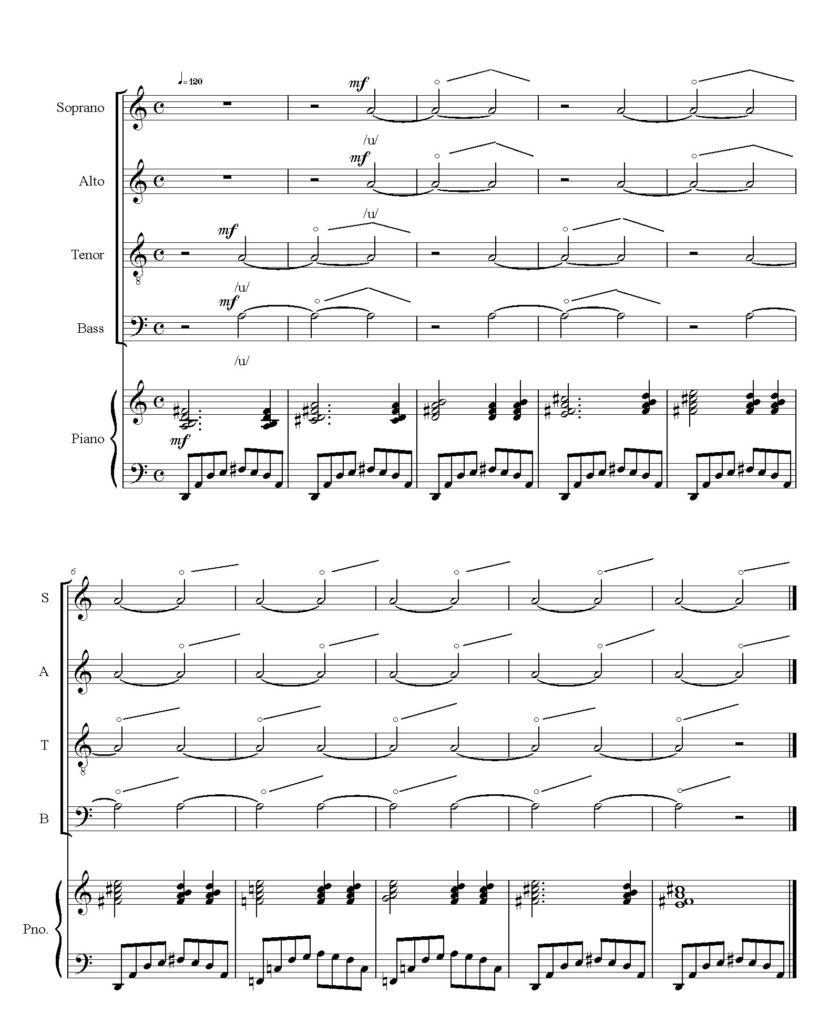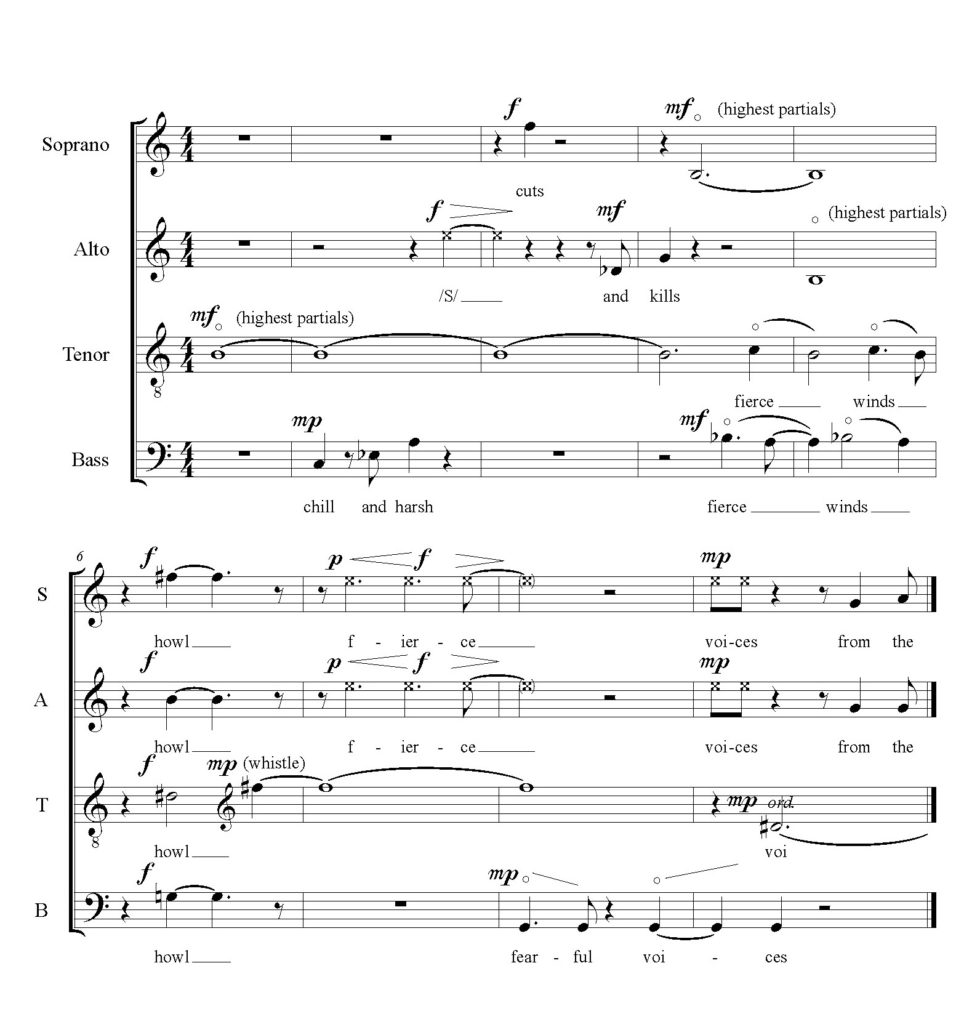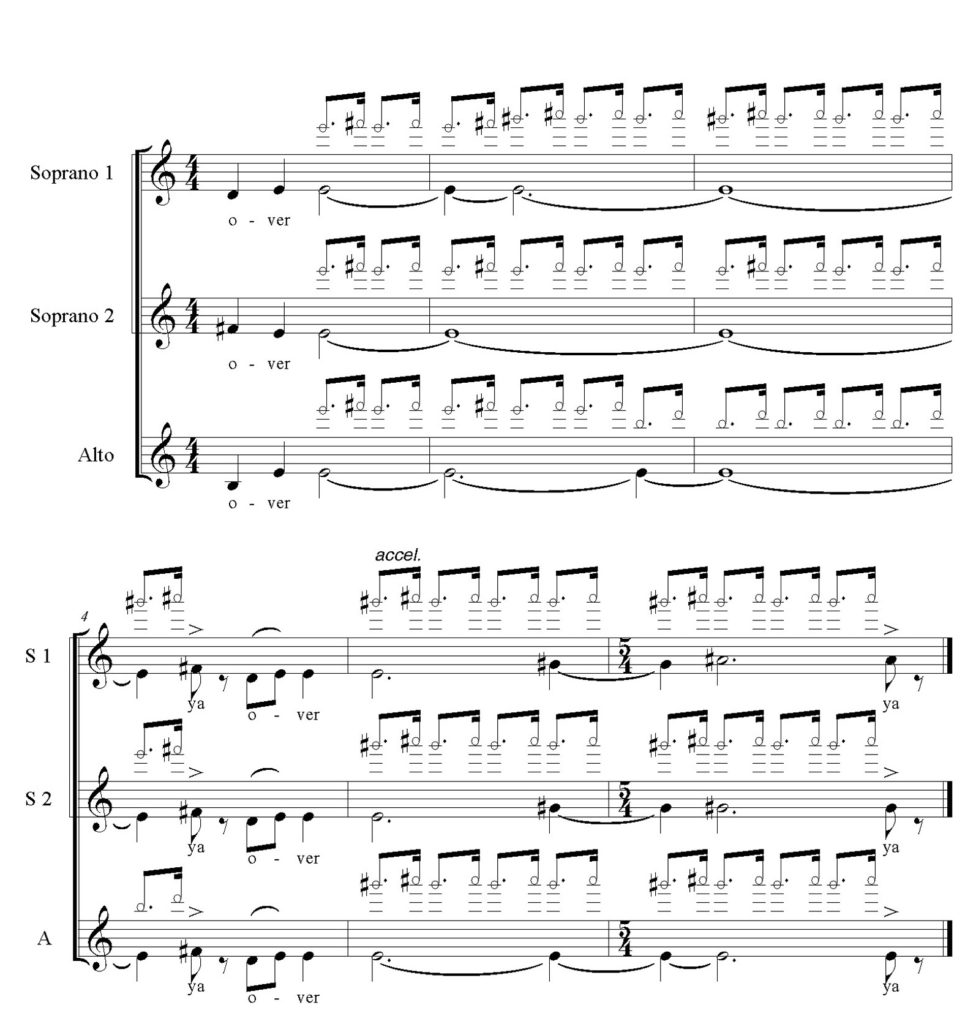El Canto Dearmónicos: Ya no sólo para Monjes o Chamanes
Stuart Hinds, compositor, cantante, director coral y maestro.
La última década ha sido testigo de un dramático incremento en la popularidad del canto dearmónicos en sus varias formas y la música coral no ha sido una excepción. Mayor cantidad de trabajos para coros con canto de armónicos han sido compuestos y más coros lo están probando. El canto de armónicos está siendo reconocido ahora como un verdadero género musical que continuará creciendo en aceptación y mayor cantidad de gente está siendo presentada a él. El canto de armónicos puede abrazar una amplia variedad de estilos musicales y posibilidades expresivas, y tiene además, un potencial enorme para obtener beneficios físicos e intelectuales. El canto de armónicos suena bien y es bueno para usted.
El propósito de este artículo es el de desmitificar el canto de armónicos y ofrecer sólidas razones para que los directores de coro lo prueben con sus coros. El canto de armónicos es mucho más que un mero efecto especial. Es un poderoso modo de expresión del que los coros pueden sacar provecho. Es también una herramienta útil para el desarrollo de la voz y el entrenamiento auditivo. Es más fácil cantar los armónicos de lo que algunos directores pueden pensar y los estudiantes lo disfrutan mucho.
Las referencias dadas al final proponen fuentes de información en tópicos que no pueden ser incluidos dentro de las limitaciones de este artículo:
- Los antecedentes históricos del canto de armónicos y sus actuales usos (Tongeren)
- Una explicación científica de lo que ocurre vocalmente en el canto de armónicos (Levin/Edgerton)
- Un método para enseñar su técnica al coro (Hinds)
Hay también una lista de composiciones recomendadas para coros usando el canto de armónicos por primera vez..
Antes de continuar, una breve definición de armónicos y sus funciones en música se impone. Cada nota musical es en realidad un sonido compuesto basado en un sonido fundamental, el cual es usualmente la altura que percibimos, combinado con un número de sonidos puros adicionales sobre él llamados armónicos. Estos armónicos no son oídos normalmente de forma individual, pero ellos son elementos importantes del sonido. La mayor o menor presencia (amplitud) de algunos de ellos sobre los demás determina el timbre o el color de la nota. Es la estructura de los armónicos, llamada “espectro”, lo que hace que el sonido de cada voz o instrumento sea único e identificable y permite distinguir los sonidos de varios instrumentos y también reconocer las voces. El significado para los cantantes es que los armónicos son la verdadera base de las vocales, timbre, resonancia y afinación.
El término “canto de armónicos” se refiere a técnicas que permiten a un cantante a aislar uno de los armónicos naturales parcialmente de la serie de armónicos de determinado tono cantado, permitiendo la audición de dos sonidos de diferente altura simultáneamente. Este fenómeno es producido por la alteración de la forma del tracto vocal en la misma forma en la que uno usa vocales hablando o cantando.
No obstante, el cantante de armónicos no está necesariamente limitado a una nota fundamental estática. El autor ha desarrollado un verdadero canto en estilo contrapuntístico produciendo vocalmente dos líneas melódicas simultáneas – la línea fundamental y la línea de armónicos. Uno puede mover ambas líneas independientemente, tanto como cada nota de la línea de armónicos sea un armónico natural de la fundamental que se está cantando. Cada vez más cantantes están comenzando a cantar polifónicamente y esta habilidad puede ser explotada en música coral.
La Figura 1 muestra un ejemplo anotado de una serie de armónicos sobre la nota fundamental Sol en el rango masculino. El patrón interválico de la serie armónica es siempre relativo a la nota fundamental. Recuerden que estas no son exactamente igual a los intervalos del temperamento igual: las octavas y las quintas son perfectas (no producen batimentos), el 5° armónico es una tercera mayor grande y el 7° y el 11° son mucho más bajos. En la medida que se progresa más allá del 12° armónico el intervalo se transforma progresivamente en más pequeño.
(Click on the image to download the full score)

Archivos de audio del autor cantando una serie de armónicos sobre Sol y una pequeña muestra polifónica de canto de armónicos puede ser escuchada en www.stuarhinds.com en la página “Sound Clips” junto con grabaciones de varias composiciones que utilizan esta técnica.
El canto de armónicos es perfectamente natural y sano para su voz cuando está hacho adecuadamente. Algunos cantantes que practican la técnica de “canto de garganta” Tuva/Mongol pueden aplicar presión muscular en el intento de suprimir la fundamental a favor de los armónicos, pero es posible producir armónicos sin tal tensión y los maestros deben monitorear a sus estudiantes para estar seguros de que ningún abuso vocal está sucediendo. Todas las manipulaciones del tracto vocal en el canto de armónicos tienen lugar en la zona de resonancia del tracto, no en la zona fonatoria. La forma que adopta el tracto vocal usada en el canto de armónicos son las mismas que aquellas utilizadas en el canto tradicional cuando se cambian vocales, registros o timbre. Ninguno de los ajustes del tracto vocal usados en el canto de armónicos son contrastantes con la buena posición abierta de la garganta en el canto.
Ha varias ventajas en el uso del canto de armónicos con el coro. Primero, tenemos el beneficio potencial del canto de armónicos relacionado al mejoramiento del canto normal, particularmente los efectos de resonancia vocal e incrementa la comprensión de las relaciones entre armónicos, vocales, resonancia y timbre. Segundo, el canto de armónicos contribuye a mejorar la musicalidad en general, como resultado del entrenamiento del oído en el reconocimiento del intervalo y la afinación (para mayor información sobre estos tópicos, ver “ArgumentfortheInvestigation and Use of OvertoneSinging” in theJournal Of Singing, Otoño de 2005).
Considere también que el canto de armónicos es una actividad multicultural, una oportunidad para aprender sobre y celebrar la música de otras culturas. El canto de armónicos le agrega variedad a los programas de concierto y a los regímenes de ensayos. Los cantantes disfrutarán al hacerlo y se beneficiarán con la experiencia.
Desde luego, la principal razón para el uso del canto de armónicos en música es la belleza de su sonido. Ese sonido distintivo es afectivo y efectivo; puede ser un poderoso medio de expresión. Cuando la gente oye el canto de armónicos por la primera vez, la reacción universal es de admiración.Con su calidad del otro mundo, es simple ver como el sonido del canto de armónicos es asociado muchas veces con elocución religiosa.
Debería enfatizarse que cualquiera puede aprender a cantar de esta manera. El autor cree firmemente que cualquiera que puede respirar, producir sonidos y formar vocales, puede realizar el canto de armónicos. Más aún, uno no tiene que ser siquiera un cantante virtuoso o un especialista en el canto de armónicos para disfrutar de él. En efecto, la mayor parte de los trabajos corales con canto de armónicos no requieren de un alto nivel técnico en este tipo de emisión. Como el género continúe su desarrollo, un repertorio será producido, incluso trabajos que demanden una amplia gama de habilidades técnicas.
Desde luego, si un coro desea tener éxito con una obra de canto de armónicos, el director debe ser muy seguro en su técnica. Si un maestro es invitado a dar un taller con un coro, el director aún debe hacer el seguimiento y tener alguna idea de lo que está sucediendo si un estudiante presenta dificultades. Para aquellos que trabajan en educación, este podría ser un buen proyecto para las vacaciones de verano o para un semestre. Usted puede aprender lo básico de la técnica en usted mismo usando el video de demostraci´øn creado por el autor para acompañar este artículo (ver más abajo). Luego, no es muy difícil encontrar algunos minutos aquí y allá para desarrollar una pequeña práctica: en la ducha, manejando, esperando por una cita o por su tetera a que hierva. Se admirará de lo bien que puede hacerlo en un par de semanas con sólo algunos minutos de práctica por día.
Un plan completo para enseñar el canto de armónicos a un coro puede ser encontrado en el artículo del autor “Howtoteachovertonesingingto a choir” en el ChoralJournal (USA), en el número correspondiente a octubre 2010. Un video de muestra por el autor que acompaña el artículo puede encontrarse en www.stuarhinds.com.
Seguramente usted se pregunta cuanto puede ser esperable de cantantes que han aprendido sólo la técnica básica. Ciertamente sus abilidades serán limitadas, pero el efecto coral de varias voces juntas hace posible lograr un excelente resultado con principiantes, especialmente coristas experimentados con buena base técnica en el comienzo. En general, no se puede esperar que los cantantes tengan mucho control en la precisión de los armónicos producidos, por lo que habrá una cierta cantidad de indeterminación y el hecho debe ser tomado en cuenta en composiciones que vayan a ser cantadas por cantantes de limitadas habilidades en el canto de armónicos. Los mejores efectos pueden ser alcanzados en situaciones musicales donde la indeterminación es en realidad una cualidad deseable.
Unos pocos ejemplos a continuación, unos que demuestran algunas maneras en que el canto de arm´ønicos puede ser efectivamente usada por coros noveles en su técnica. En todas estas composiciones fue buscada la incorporación e integración de canto de armónicos de forma significativa y musical. Muestran cuan variadas técnicas de canto de armónicos fueron empleadas para realizar exclusivamente efectos musicales tales como el contraste tímbrico, el gesto dramático y la creación de textura. Además, también presentamos algunas formas de canto de armónicos puede ser evocativa del texto (o mejor, evocadas por el texto).
Considere la composición Autum Moon (SATB con piano y algunos divisi). La mayoría de la obra carece totalmente de canto de armónicos. Hay sólo un par de apariciones fugaces donde el canto de armónicos es usado como pintando el texto (en “orwhenithidesfor a momentbehind a passingcloud” – o cuando se esconde por un momento detrás del paso de una nube – y “I hearthesong of thewind in thebranches” – Escucho el canto del viento en las ramas – En estos pasajes a los cantantes se les dio solamente la nota fundamental y se les permite improvisar en la serie que mejor funcione para ellos, por lo que se forma un sutil pero compleja y colorida textura. El canto de armónicos está presentado principalmente sólo en un pasaje donde la melodía y la armonía son tomadas por el piano mientras el coro va creando una textura similar al arpa en glissandi de canto de armónicos, con las voces femeninas alternándose y sobreponiéndose a las masculinas (Figura 2). Los coristasno necesitan precisión en el unísono de los armónicos en este glissandi mientras creen el ambiente deseado, ascendiendo o descendiendo en el metro correcto. El pequeño círculo de la cabeza de la nota indicando armónicos es la que se utiliza técnicamente para las cuerdas. La vocal /u:/ está indicada para producir el armónico grave como punto de partida del glissando, no para ser mantenida.
(Click on the image to download the full score)

Es común en el canto de armónicos en una obra coral de constituirse de no más de una nota fundamental dada y la dirección hacia donde producir los armónicos ad libitum, pero es fácil de hacer más sin elevar el nivel de dificultad. Simples instrucciones verbales pueden ser usadas para sugerir más específicos efectos. En un pasaje de Winter (SATB a capella), se les pide a los coristas que se concentren en el armónico más agudo posible para ilustrar las imágenes de frío helado del texto. Más adelante, el texto por sí mismo está utilizado para generar efectos de canto de armónicos.. En la parte del bajo, compás 45, los diptongos en las palabras están elongados para producir glissandi de armónicos descendentes – “fierce” y “fearful” (/i3/) y ascendentes – “voices” (/oi/).
(Click on the image to download the full score)

En esta pieza para dos voces de coro de niños, la /n/ es usada alternadamente con el canto de armónicos para crear un efecto “on/off” de los armónicos. El uso de la vocal /i/ significa que el armónico más agudo deberá ser producido. Nuevamente, el gesto de glissando descendente está anotado gráficamente.
(Click on the image to download the full score)

A pesar de que los armónicos graves de cualquier nota fundamental es una tríada, el canto de armónicos no está limitada a la música tonal o modal. Cualquier tipo de configuración acórdica puede ser usada en la parte fundamental. En este pasaje de MeeresStille (SATB a capella) un cluster de tono entero está construido sin armónicos y luego éstos han sido añadidos en un gesto dinámico. La /u/vocal producirá los armónicos graves.
(Click on the image to download the full score)

El siguiente ejemplo de TheWind (SSA a capella) utiliza el canto de armónicos rítmicamente y una celebración de los orígenes étnicos del canto de armónicos en Asia Central. La ide proviene del canto de garganta Tuva, donde el ritmo puntillado es usado para representar el sonido de los caballos galopando. En este caso, fueron anotados armónicos específicos, pero pueden ser tratados como indeterminados ya que es un gesto rítmico en los alrededores del tono lo que tiene mayor relevancia. Otros pasajes en este trabajo utiliza armónicos glissando para representar el silbido del viento.
(Click on the image to download the full score)

No se debe pensar que el canto de armónicos en música coral está limitada a este tipo de texturas. Hay cada vez más y más trabajos compuestos que llaman a un nivel más alto de habilidades en el canto de armónicos, requiriendo control de los armónicos cantando hasta de forma polifónica. Mayores habilidades permiten mayor rango de expresión musical.
Se estimula a los directores de coros de todas las edades y niveles de canto que consideren probar el canto de armónicos. Es más fácil cantar armónicos de lo que algunos directores podrían pensar. La técnica básica puede ser enseñada en unos pocos minutos y no requiere de demasiado tiempo de ensayo para hacer progresos. El canto de armónicos puede ser incorporado fácilmente en el régimen de precalentamiento y es una plataforma formidable para enseñar o mejorar la resonancia vocal y afinación. El tiempo utilizado en el canto de armónicos pagará dividendos en mayor conciencia de la voz, incremento del conocimiento musical y el regocijo del canto.
Para ayudar a su comienzo, se ofrece una lista de composiciones para coros con canto de armónicos. Esta información es fundamentalmente dirigida a directores que nunca utilizaron el canto de armónicos con sus coros. Estos trabajos han sido recomendados porque ofrecen una buena posibilidad de éxito y los coristas han disfrutado cantándolos. El principal criterio de selección para estas piezas fue que sirvieran para coros usando el canto de armónicos por primera vez. Esto significa que no se pretende que los coristas canten armónicos específicos o cambien de fundamental mientras cantan. El resultado del canto de armónicos es, por lo tanto, algo indeterminado, pero el tipo de textura puede ser usada con buenos efectos en determinadas situaciones musicales, como lo atestiguan estos trabajos.
Ben Allaway – Walking Songs (2002, Thresholds)
VaclovasAugustinas – AnojpuséjDunojélio (Hinshaw)
Stuart Hinds – Autumn Moon (2004, Hofmeister)
Stuart Hinds – Winter (2005, Hofmeister)
Sarah Hopkins – Past Life Melodies (1991, Morton Music, several voicings available)
Knut Nystedt – Immortal Bach (1988, NorskMusikforlag)
PeterisVasks – Piedzimšana(2008, Schott)
Referencias
Hinds, Stuart:An Overtone Experience/EineObertonErfahrung, Traumzeit, 2012.
-‘Argument for the Investigation and Use of Overtone Singing’,Journal of Singing, Fall 2005.
-‘How To Teach Overtone Singing to a Choir’,Choral Journal, October 2010.
-‘New Music for Chorus with Overtone Singing’,Choral Journal, March 2007.
Levin, Theodore C. and Michael E. Edgerton: ‘The Throat Singers of Tuva’,Scientific American, September 1999.
Tongeren, Mark C. van:Overtone Singing: Physics and Metaphysics of Harmonics in East and West, Amsterdam: Fusica, 2002.
 Stuart Hinds es un activo compositor, cantante, director y maestro. La mayoría de sus composiciones envuelven el uso del canto de armónicos, incluidos trabajos para solistas, voz e instrumentos y trabajos corales. Hinds ha presentado conciertos, conferencias-demostraciones y talleres a lo largo de los EE.UU. y Europa. Es un compositor y autor que ha sido publicado en artículos del ChoralJournal y el Journal of Singing y las obras corales con Friedrich HofmeisterMusikverlag. Hinds obtuvo su Doctorado en Artes Musicales en composición musical en la Universidad de Michigan: stuarhinds@yahoo.com
Stuart Hinds es un activo compositor, cantante, director y maestro. La mayoría de sus composiciones envuelven el uso del canto de armónicos, incluidos trabajos para solistas, voz e instrumentos y trabajos corales. Hinds ha presentado conciertos, conferencias-demostraciones y talleres a lo largo de los EE.UU. y Europa. Es un compositor y autor que ha sido publicado en artículos del ChoralJournal y el Journal of Singing y las obras corales con Friedrich HofmeisterMusikverlag. Hinds obtuvo su Doctorado en Artes Musicales en composición musical en la Universidad de Michigan: stuarhinds@yahoo.com
Traducción: Oscar Escalada, Argentina